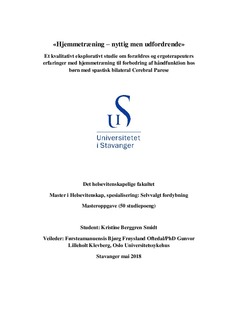| dc.contributor.advisor | Oftedal, Bjørg | |
| dc.contributor.author | Smidt, Kristine | |
| dc.coverage.spatial | Norway | nb_NO |
| dc.date.accessioned | 2018-09-17T08:36:45Z | |
| dc.date.available | 2018-09-17T08:36:45Z | |
| dc.date.issued | 2018-05-30 | |
| dc.identifier.uri | http://hdl.handle.net/11250/2562877 | |
| dc.description | Master's thesis in Health and social sciences | nb_NO |
| dc.description.abstract | Baggrund: På trods af mangel på kundskab om håndfunktion hos børn med spastisk bilateral CP og hvilke interventioner, som kan fremme deres håndfunktion, har hjemmetræningsprogrammer vist lovende resultater, og kan bruges til børn med spastisk bilateral CP. Der er imidlertid behov for flere studier, som belyser forældres og ergoterapeuters erfaringer med implementering af hjemmeprogrammer.
Hensigt: At udforske forældres og ergoterapeuters erfaringer med et målrettet hjemmetræningsprogram til forbedring af håndfunktion hos børn med spastisk bilateral Cerebral Parese.
Metode: Et kvalitativt eksplorativt studie med en kvantitativ komponent. Fem forældre og tre ergoterapeuter blev interviewet i to separate fokusgrupper. Datamaterialet blev analyseret ved hjælp af kvalitativ indholdsanalyse. Interventionen indeholdt daglig målrettet træning, 25-33 timer i otte uger, med et ugentligt besøg af ergoterapeuten. The Canadian Occupational Performance Measure og Goal Attainment Scale blev brugt til målsætning og evaluering.
Fund: Tre temaer blev identificeret; 1) Hjemmetræning fremmer bevidsthed og barnets mestring 2) Hjemmetræning er udfordrende og udmattende over tid 3) En nødvendig forældrestøtte og fokus på barnets ”stemme”. Forældrene rapporterede om ændringer i barnets aktivitetsudførelse og målopnåelse i brug af hænder i daglige aktiviteter.
Konklusion: Fundene indikerer, at hjemmetræningen var nyttig men udfordrende, samt at motivation ser ud til at være en nøglefaktor ved implementering af hjemmetræning. Kontinuerlig støtte til forældrene og styrkelse af barnets involvering kan være vigtige faktorer for stimulering af motivation. Videre forskning bør fokusere på strategier, som kan fremme indre motivation, og en ”hybrid” model for hjemmetræning fordelt mellem hjemmet og børnehave/skole kan være relevant at afprøve i et pilotstudie. | nb_NO |
| dc.description.abstract | Background: Despite limited knowledge about hand function in the subtype of children with spastic bilateral Cerebral Palsy and lacking evidence of the effect of hand function interventions for this subtype, home programmes have shown promising results. However, more research about parents’ and occupational therapists’ experience of implementing home programmes is needed.
Aim: To explore parents’ and occupational therapists’ experiences with a home programme using goal-directed training to improve hand function for children with spastic bilateral Cerebral Palsy.
Method: The study is qualitative exploratory and includes a quantitative component. Five parents and three occupational therapists were interviewed in separate focus groups. Transcripts were analyzed by qualitative content analysis. The intervention consisted of daily goal-directed training, 25-33 hours during eight weeks. Weekly visits from the occupational therapist were provided. The Canadian Occupational Performance Measure and Goal Attainment Scale were used for goalsetting and evaluation.
Findings: Three themes were identified; 1) Home training promotes parent awareness and the child’s mastery, 2) Home training is challenging and exhausting over time, and 3) Parent support is necessary, and the child’s involvement is important. The parents reported changes in the childs’s occupational performance and goal attainment in use of hands in daily activities.
Conclusion: The findings indicate that the home programme was beneficial but challenging, and that motivation is a key factor for implementing home-based intervention. Ongoing support to the parents, as well as strengthening the children’s involvement can be important for stimulating motivation. Future research should focus on developing strategies to enhance intrinsic motivation, and a ”hybrid” model for home training divided between home and kindergarten/school should be explored. | nb_NO |
| dc.language.iso | dan | nb_NO |
| dc.publisher | University of Stavanger, Norway | nb_NO |
| dc.relation.ispartofseries | Masteroppgave/UIS-HV/2018; | |
| dc.rights | Attribution-NonCommercial-NoDerivatives 4.0 Internasjonal | * |
| dc.rights.uri | http://creativecommons.org/licenses/by-nc-nd/4.0/deed.no | * |
| dc.subject | helsevitenskap | nb_NO |
| dc.subject | helse- og sosialfag | nb_NO |
| dc.subject | cerebral parese (CP) | nb_NO |
| dc.title | Hjemmetræning - nyttig med udfordrende | nb_NO |
| dc.type | Master thesis | nb_NO |
| dc.description.version | submittedVersion | nb_NO |
| dc.subject.nsi | VDP::Medisinske Fag: 700::Helsefag: 800 | nb_NO |

